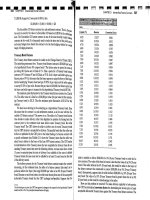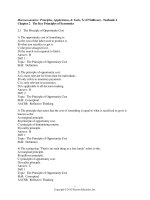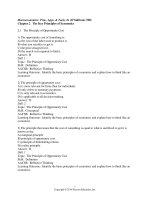MacroEcomonics principles, application, and tools 7th edition by sullivan chapter 08
Bạn đang xem bản rút gọn của tài liệu. Xem và tải ngay bản đầy đủ của tài liệu tại đây (779.65 KB, 32 trang )
CHAPTER 8
Why do Economies
Grow?
Copyright © 2012 Pearson
Prentice
Hall.
All rights
reserved.
Copyright
© 2012
Pearson
Prentice
Hall. All rights reserved.
8-1
CHAPTER
Why do Economies Grow?
8
For many people, the thought of poverty conjures up poor, African children,
but since 1995, African poverty rates have been falling steadily.
PREPARED BY
Copyright © 2012 Pearson Prentice Hall. All rights reserved.
Brock Williams
CHAPTER 8
Why do Economies
Grow?
APPLYING THE CONCEPTS
1
How my global warming affect economic growth?
Global Warming, Rich Countries and Poor Countries
2
Does economic growth necessarily cause more inequality?
Growth Need Not Cause Increased Inequality
3
How can we use economic analysis to understand the sources of growth in
different countries?
Sources of Growth in China and India
4
How much did the information revolution contribute to U.S. productivity growth?
Growth Accounting and Information Technology
5
How do varying political institutions affect economic growth?
The Role of Political Factors in Economic Growth
6
Did cultural or evolution spark the Industrial Revolution?
Culture, Evolution, and Economic Growth
7
Why are clear property rights important for economic growth in developing
countries?
Lack of Property Rights Hinders Growth in Peru
Copyright © 2012 Pearson Prentice Hall. All rights reserved.
8-3
CHAPTER 8
Why do Economies
Grow?
8.1
ECONOMIC GROWTH RATES
● capital deepening
Increases in the stock of capital per worker.
● technological progress
More efficient ways of organizing economic
affairs that allow an economy to increase
output without increasing inputs.
● human capital
The knowledge and skills acquired by a
worker through education and experience and
used to produce goods and services.
Copyright © 2012 Pearson Prentice Hall. All rights reserved.
8-4
CHAPTER 8
Why do Economies
Grow?
8.1
ECONOMIC GROWTH RATES (cont’d)
FIGURE 8.1
What Is Economic Growth?
Economic growth means
an expanded production
possibilities curve (PPC).
Copyright © 2012 Pearson Prentice Hall. All rights reserved.
8-5
CHAPTER 8
Why do Economies
Grow?
8.1
ECONOMIC GROWTH RATES (cont’d)
Measuring Economic Growth
● real GDP per capita
Gross domestic product per person adjusted for
changes in prices. It is the usual measure of living
standards across time and between countries.
● growth rate
The percentage rate of change of a variable
from one period to another.
Copyright © 2012 Pearson Prentice Hall. All rights reserved.
8-6
CHAPTER 8
Why do Economies
Grow?
8.1
ECONOMIC GROWTH RATES (cont’d)
Measuring Economic Growth
● rule of 70
A rule of thumb that says output will
double in 70/x years, where x is the
percentage rate of growth.
Copyright © 2012 Pearson Prentice Hall. All rights reserved.
8-7
CHAPTER 8
Why do Economies
Grow?
8.1
ECONOMIC GROWTH RATES (cont’d)
Comparing the Growth Rates of Various Countries
Copyright © 2012 Pearson Prentice Hall. All rights reserved.
8-8
CHAPTER 8
Why do Economies
Grow?
APPLICATION
1
GLOBAL WARMING, RICH COUNTRIES, AND POOR
COUNTRIES
APPLYING THE CONCEPTS #1: How may global warming affect
economic growth?
The effects of global warming on economic development are very complex
▪ The effect of increases in temperature seem to be confined to
poor countries
▪ In Latin and South America, each 1 degree Celsius increase
resulted in a 1.2 to 1.9 percent decline in per capita income
▪ Exports also declined between 2.0 and 5.7 percent.
▪ By deferring global warming into the future, poor countries may
have time to develop and avoid the worst of the impact.
Copyright © 2012 Pearson Prentice Hall. All rights reserved.
8-9
CHAPTER 8
Why do Economies
Grow?
8.1
ECONOMIC GROWTH RATES (cont’d)
Are Poor Countries Catching Up?
● convergence
The process by which poorer countries close the gap with richer
countries in terms of real GDP per capita.
► FIGURE 8.2
Growth Rates versus Per Capita
Income, 1870–1979
Each point on the graph represents a
different currently developed country.
Notice that the countries with the lowest
per capita incomes in 1870 (shown
along the horizontal axis) are plotted
higher on the graph.
In other words, the tendency was for
countries with lower levels of initial
income to grow faster.
Copyright © 2012 Pearson Prentice Hall. All rights reserved.
8-10
CHAPTER 8
Why do Economies
Grow?
APPLICATION
2
GROWTH NEED NOT CAUSE INCREASED INEQUALITY
APPLYING THE CONCEPTS #2: Does economic growth
necessarily cause more inequality?
Economists believed that as a country developed, inequality within a country
followed an inverted “U” pattern—inequality initially increased and then narrowed
over time. Recent research challenges the assumption that this phenomenon is
solely the result of growth:
▪ Inequality increased from 40 percent at the beginning of the 1920s to 45
percent through the end of the Great Depression.
▪ During World War II inequality fell to 32 percent by 1944 and remained at that
level until the early 1970s, at which time it began to again increase.
▪ Wage and price controls during World War II reduced differentials in wages and
salaries and thereby reduced inequality.
▪ After the 1970s, salaries at the top of the income distribution increased sharply.
Inequality does not naturally accompany economic development. Other factors also
play a role:
▪ Social norms
▪ Perceived fairness of compensation
▪ Nature of the tax system
Copyright © 2012 Pearson Prentice Hall. All rights reserved.
8-11
CHAPTER 8
Why do Economies
Grow?
8.2
CAPITAL DEEPENING
► FIGURE 8.3
Increase in the Supply of
Capital
An increase in the supply of
capital will shift the production
function upward, as shown in
Panel A, and increase the
demand for labor, as shown in
Panel B.
Real wages will increase from
W1 to W2, and potential output
will increase from Y1 to Y2.
Copyright © 2012 Pearson Prentice Hall. All rights reserved.
8-12
CHAPTER 8
Why do Economies
Grow?
8.2
CAPITAL DEEPENING (cont’d)
Saving and Investment
● saving
Income that is not consumed.
Copyright © 2012 Pearson Prentice Hall. All rights reserved.
8-13
CHAPTER 8
Why do Economies
Grow?
8.2
CAPITAL DEEPENING (cont’d)
How Do Population Growth, Government, and Trade Affect Capital
Deepening?
PRINCIPLE OF DIMINISHING RETURNS
Suppose output is produced with two or more inputs, and we increase one
input while holding the other input or inputs fixed. Beyond some point—called
the point of diminishing returns—output will increase at a decreasing rate.
► FIGURE 8.4
Taxes and Government
Investment
If the government raises taxes by
$100 and the people tend to save
20 percent of changes in income,
then private savings and investment
will fall by $20.
However, if the government invests
the funds, then total investment—
private and public— will increase by
$80.
Copyright © 2012 Pearson Prentice Hall. All rights reserved.
8-14
CHAPTER 8
Why do Economies
Grow?
8.3
THE KEY ROLE OF
TECHNOLOGICAL PROGRESS
How Do We Measure Technological Progress?
● growth accounting
A method to determine the contribution to
economic growth from increased capital,
labor, and technological progress.
Copyright © 2012 Pearson Prentice Hall. All rights reserved.
8-15
CHAPTER 8
Why do Economies
Grow?
8.3
THE KEY ROLE OF
TECHNOLOGICAL PROGRESS (cont’d)
How Do We Measure Technological Progress?
► FIGURE 8.5
Contributions to Real
GDP Growth, 1929–
1982 (average annual
percentage rates)
Copyright © 2012 Pearson Prentice Hall. All rights reserved.
8-16
CHAPTER 8
Why do Economies
Grow?
8.3
THE KEY ROLE OF
TECHNOLOGICAL PROGRESS (cont’d)
Using Growth Accounting
•Growth accounting is a useful tool for understanding different aspects of
economic growth.
•As an example, economic growth slowed throughout the entire world during
the 1970s.
•Using growth accounting methods, economists typically found the
slowdown could not be attributed to changes in the quality or quantity of
labor inputs or to capital deepening.
•Either a slowdown in technological progress or other factors not directly
included in the analysis, such as higher worldwide energy prices, must
have been responsible.
•This led economists to suspect that higher energy prices were the
primary explanation for the reduction in economic growth.
Copyright © 2012 Pearson Prentice Hall. All rights reserved.
8-17
CHAPTER 8
Why do Economies
Grow?
APPLICATION
3
SOURCES OF GROWTH IN CHINA AND INDIA
APPLYING THE CONCEPTS #3: How can we use economic analysis to
understand the sources of growth in different countries?
China and India are the two most populous countries and have also grown
very rapidly in recent years.
From 1978 to 2004, GDP in China grew at the rate of 9.3 percent per year
while India’s GDP grew at a lower rate of 5.4 percent per year.
Economists Barry Bosworth from the Brookings Institution and Susan
Collins from the University of Michigan used growth accounting to answer
this question.
▪ China’s rapid growth was caused by more rapid accumulation of
physical capital and more rapid technological progress.
▪ China invested much more in physical capital and was able to
increase its technological progress at a more rapid rate.
Copyright © 2012 Pearson Prentice Hall. All rights reserved.
8-18
CHAPTER 8
Why do Economies
Grow?
APPLICATION
4
GROWTH ACCOUNTING AND INFORMATION TECHNOLOGY
APPLYING THE CONCEPTS #4: How much did the information
revolution contribute to U.S. productivity growth?
FIGURE 8.6
U.S. Annual Productivity Growth, 1959–2007
In recent years, there has been a resurgence of productivity growth in part
caused by the information technology revolution.
Copyright © 2012 Pearson Prentice Hall. All rights reserved.
8-19
CHAPTER 8
Why do Economies
Grow?
8.4
WHAT CAUSES
TECHNOLOGICAL PROGRESS?
Research and Development Funding
▼ FIGURE 8.7
Research and Development as a Percent of GDP, 1999
The United States spends more total money than any other country on research and
development.
However, when the spending is measured as a percentage of each nation’s GDP, Japan spends
more.
A big part of U.S. spending on research and development is in defense-related areas.
Copyright © 2012 Pearson Prentice Hall. All rights reserved.
8-20
CHAPTER 8
Why do Economies
Grow?
8.4
WHAT CAUSES
TECHNOLOGICAL PROGRESS? (cont’d)
Monopolies That Spur Innovation
● creative destruction
The view that a firm will try to come up with
new products and more efficient ways to
produce products to earn monopoly profits.
The Scale of the Market
•Adam Smith stressed that the size of a market was important for economic
development.
•In larger markets, firms have more incentives to come up with new products
and new methods of production. The lure of profits guides the activities of
firms, and larger markets provide firms the opportunity to make larger profits.
•This supplies another rationale for free trade. With free trade, markets are
larger, and there is more incentive to engage in technological progress.
Copyright © 2012 Pearson Prentice Hall. All rights reserved.
8-21
CHAPTER 8
Why do Economies
Grow?
8.4
WHAT CAUSES
TECHNOLOGICAL PROGRESS? (cont’d)
Induced Innovations
Some economists have emphasized that innovations come about through
inventive activity designed specifically to reduce costs. This is known as
induced innovation.
Education, Human Capital, and the Accumulation of
Knowledge
Education can contribute to economic growth in two ways.
▪ First, the increased knowledge and skills of people complement our current
investments in physical capital.
▪ Second, education can enable the workforce in an economy to use its skills to
develop new ideas or to copy ideas or import them from abroad.
New Growth Theory
● new growth theory
Modern theories of growth that try to explain the
origins of technological progress.
Copyright © 2012 Pearson Prentice Hall. All rights reserved.
8-22
CHAPTER 8
Why do Economies
Grow?
APPLICATION
5
THE ROLE OF POLITICAL FACTORS IN ECONOMIC
GROWTH
APPLYING THE CONCEPTS #5 How do varying political
institutions affect economic growth?
Growth can, and has, occurred in both authoritarian and participatory governments.
Transformative economic growth like the Industrial Revolution usually requires
participatory institutions.
▪ Sustained technological progress is disruptive and authoritarian regimes
have difficulty dealing with the change.
▪ The old monarchies of Europe fell and were replaced with democracies or
limited monarchies.
▪ Can China maintain strong economic growth without political
transformation?
Copyright © 2012 Pearson Prentice Hall. All rights reserved.
8-23
CHAPTER 8
Why do Economies
Grow?
APPLICATION
6
CULTURE, EVOLUTION. AND ECONOMIC GROWTH
APPLYING THE CONCEPTS #6: Did culture or evolution spark
the Industrial Revolution?
In studying the economic history of England before the Industrial Revolution,
Professor Clark discovered an interesting fact.
▪ He found that children of the more affluent members of English society were
more likely to survive than those of the less affluent.
▪ With the slow growth of population over several centuries, this differential
survival of the wealthy had the effect of creating downward mobility for the
rich, as their sons and daughters increasingly populated the society.
This change had profound effects on English society. The cultural habits of the
rich filtered through the entire society.
▪ Social virtues such as thrift, prudence, and hard work became more
commonplace, while impulsive and violent behaviors were reduced.
▪ Eventually, these changes in culture became sufficiently pronounced that
a qualitative change took place in society.
Copyright © 2012 Pearson Prentice Hall. All rights reserved.
8-24
CHAPTER 8
Why do Economies
Grow?
8.5
A KEY GOVERNMENTAL ROLE: PROVIDING THE
CORRECT INCENTIVES AND PROPERTY RIGHTS
What is the connection between property rights and economic growth?
• Without clear property rights, there are no proper incentives to invest in the
future—the essence of economic growth.
What else can go wrong?
• Governments in developing countries often:
• Adopt policies that effectively tax exports
• Pursue policies that lead to rampant inflation
• Enforce laws that inhibit the growth of the banking and financial sectors
Results:
• Fewer exports
• Uncertain financial environment
• Reduced saving and investment
With the right incentives, individuals and firms in developing countries will take
actions that promote economic growth.
Copyright © 2012 Pearson Prentice Hall. All rights reserved.
8-25









